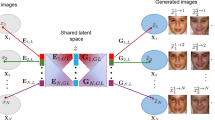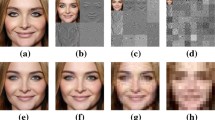Abstract
Most existing state-of-the-art face aging models primarily focus on an adult or long-span aging and modeling age transformation in the image domain. This work proposes a child and adult face aging framework that captures more texture and shape information using attention with a wavelet-transformation-based generative adversarial network in the frequency domain. To facilitate child and adult age synthesis, we adopt a wavelet-based multi-scale patch discriminator, which increases the stability of model training and captures local texture details of the child and adult faces. Moreover, we introduce a modified convolutional block attention module, emphasizing only facial regions related to a target attribute and preserving the attribute-excluding details. Our new objective function, modified attention generator, and wavelet multi-scale patch discrimination has shown qualitative and quantitative improvements over the state-of-the-art approaches in terms of face recognition and age estimation on benchmarked children and adult datasets.









Similar content being viewed by others
Notes
United Nations Convention on the Rights of the Child defines child as “A human being below the age of 18 years unless, under the law applicable to the child, the majority has been attained earlier” [1]
We use face aging, age progression alternately in this paper.
We use face de-aging, rejuvenation and age regression alternately in this paper.
This particular COTS is also one of the best performers in the NIST ongoing Face Recognition Vendor Test (FRVT).
References
UNICEF: United nations children’s fund. www.unicef-irc.org/portfolios/crc-optional-2.html/ (2000)
United nations office on drugs and crime. www.unodc.org/unodc/data-and-analysis
National crime information center. www.fbi.gov/services/cjis/ncic
Missing children statistics. globalmissingkids.org/awareness/missing-children-statistics/
Face recognition system. https://timesofindia.indiatimes.com/city/delhi/delhi-facial-recognition-system
BBC: ;little boy lost finds his mother using google earth (2014). www.bbc.com/news/magazine/
Zhang Z, Song Y, Qi H (2017) Age progression/regression by conditional adversarial autoencoder. In: IEEE CVPR, pp 4352–4360
Yang H, Huang D, Wang Y, Jain AK (2018) Learning face age progression: a pyramid architecture of gans. In: CVPR, pp 31–39
Wang Z, Tang X, Luo W, Gao S (2018) Face aging with identity-preserved conditional generative adversarial networks. In: (CVPR), pp 7939–7947
Sun Y, Tang J, Shu X, Sun Z, Tistarelli M (2020) Facial age synthesis with label distribution-guided generative adversarial network. IEEE transactions on information forensics and security pp 2679–2691
Chandaliya PK, Sinha A, Nain N (2020) Childface: gender aware child face aging. In: BIOSIG, pp 255–263
Deb D, Nain N, Jain AK (2018) Longitudinal study of child face recognition. In: ICB, pp 225–232
Srinivas N, Ricanek K, Michalski D, Bolme DS, King, M (2019) Face recognition algorithm bias: performance differences on images of children and adults. In CVPRW, 2019, pp 2269–2277
Schroff F, Kalenichenko D, Philbin J (2015) Facenet: a unified embedding for face recognition and clustering In CVPR, pp 815–823
Shi Y, Jain A (2019) Probabilistic face embeddings. In: (ICCV), pp 6901–6910
Deng J, Guo J, Niannan X, Zafeiriou S (2019) Arcface: Additive angular margin loss for deep face recognition. In: CVPR, pp 4685–4694
Patrick J Grother Mei L Ngan, K.K.H (2018) Ongoing face recognition vendor test(frvt) part 2: Identification. In: NIST interagency report
Chandaliya PK, Nain N (2021) Child face age progression and regression using self-attention multi-scale patch gan. In: 2021 IEEE International joint conference on biometrics (IJCB), pp 1–8
Mao X, Li Q, Xie H, Lau RYK, Wang Z, Smolley SP (2017) Least squares generative adversarial networks. In: (ICCV), pp 2813–2821
Kemelmacher-Shlizerman I, Suwajanakorn S, Seitz SM (2014) Illumination-aware age progression. In: (CVPR), pp 3334–3341
Wang H, Wang Y, Li Wea (2020) Adaptive morphological and bilateral filtering with ensemble convolutional neural network for pose-invariant face recognition. In: J Ambient Intell Human Comput, vol. 11, pp 1153-1162
Liang Y, Xu Y, Liu L, Liao S, Zou B (2011) chap. A multi-layer model for face aging simulation, Trans. Edutainment 6 (2011), pp 182–192
Ramanathan N, Chellappa R (2006) Modeling age progression in young faces. In: CVPR, pp 387–394
Antipov G, Baccouche M, Dugelay J (2017) Face aging with conditional generative adversarial networks. In: ICIP, pp 2089–2093. IEEE
Antipov G, Baccouche M, Dugelay J (2017) Boosting cross-age face verification via generative age normalization. In: IEEE. BTAS, pp 191–199
Palsson S, Agustsson E, Timofte R, Van Gool L (2018) Generative adversarial style transfer networks for face aging. In: 2018 IEEE (CVPRW), pp 2165–21658
Zhang K, Su Y, Guo X, Qi L, Zhao Z (2021) Mu-gan: Facial attribute editing based on multi-attention mechanism. IEEE/CAA J Automatica Sin 614-1626. https://doi.org/10.1109/JAS.2020.1003390
Woo S, Park J, Lee JY, Kweon IS (2018) Cbam: Convolutional block attention module. In: computer vision – ECCV 2018, pp. 13–19. Springer International Publishing
Yang J, Ren P, Zhang D, Chen D, Wen F, Li H, Hua G (2017) Neural aggregation network for video face recognition. In: 2017 IEEE Conference on Computer Vision and Pattern Recognition (CVPR), pp 5216–5225 . https://doi.org/10.1109/CVPR.2017.554
Fu J, Liu J, Tian H, Li Y, Bao Y, Fang Z, Lu H (2019) Dual attention network for scene segmentation. In: Proceedings of the IEEE Conference on computer vision and pattern recognition, pp 3146–3154
Cao Y, Xu J, Lin S, Wei F, Hu H (2019) Gcnet: Non-local networks meet squeeze-excitation networks and beyond. In: 2019 IEEE/CVF International Conference on Computer Vision Workshop (ICCVW), pp 1971–1980 . https://doi.org/10.1109/ICCVW.2019.00246
Hu J, Shen L, Sun G (2018) Squeeze-and-excitation networks. In: IEEE/CVF Conference on Computer Vision and Pattern Recognition, pp 7132–7141
Wang Q, Wu B, Zhu P, Li P, Zuo W, Hu Q (2020) Eca-net: Efficient channel attention for deep convolutional neural networks. In: The IEEE conference on computer vision and pattern recognition (CVPR), pp 11531–11539
Zhang H, Goodfellow I, Metaxas D, Odena A (2019) Self-attention generative adversarial networks. In: ICML, pp 7354–7363. PMLR
Park J, Woo S, Lee JY, Kweon IS (2018) Bam: bottleneck attention module. In: BMVC, pp 1–7
Wang TC, Liu MY, Zhu JY, Tao A, Kautz J, et al (2018) High-resolution image synthesis and semantic manipulation with conditional gans. In: IEEE(CVPR), pp 8798–8807
Perarnau G, van de Weijer J, Raducanu B, Álvarez JM (2016) Invertible Conditional GANs for image editing. In: NIPS, pp 1–8
Krizhevsky A, Sutskever I, Hinton GE (2012) Imagenet classification with deep convolutional neural networks. In: NIPS, pp 1097–1105
Johnson J, Alahi A, Fei-Fei L (2016) Perceptual losses for real-time style transfer and super-resolution. In: computer vision – ECCV 2016, pp 694–711
Wang Z, Simoncelli E, Bovik A (2003) Multiscale structural similarity for image quality assessment. In: The thrity-seventh asilomar conference on signals, systems computers 2, pp 1398–1402
Chandaliya PK, Nain N (2022) Childgan: face aging and rejuvenation to find missing children. Pattern Recogn 129:108761. https://doi.org/10.1016/j.patcog.2022.108761
Chen BC, Chen CS, Hsu WH (2014) Cross-age reference coding for age-invariant face recognition and retrieval. In: ECCV
Fu Y, Hospedales TM, Xiang T, Yao Y, Gong S (2014) Interestingness prediction by robust learning to rank. In: ECCV
Zhang K, Zhang Z, Li Z, Qiao Y (2016) Joint face detection and alignment using multitask cascaded convolutional networks. IEEE signal process. Lett. pp 1499–1503
Chandaliya PK, Nain N (2019) Conditional perceptual adversarial variational autoencoder for age progression and regression on child face. In: (ICB), pp 1–8
Chandaliya PK, Nain N (2021) Child face age progression and regression using self-attention multi-scale patch gan. In: 2021 IEEE International joint conference on biometrics (IJCB), pp 1–8
Yang TY, Huang YH, Lin YY, Hsiu PC, Chuang YY (2018) Ssr-net: a compact soft stagewise regression network for age estimation. In: IJCAI-18, pp 1078–1084
Cao Q, Shen L, Xie W, Parkhi OM, Zisserman A (2018) Vggface2: A dataset for recognising faces across pose and age. In: International conference on automatic face and gesture recognition, pp 1-8
Guo Y, Zhang L, Hu Y, He X, Gao J (2016) Ms-celeb-1m: a dataset and benchmark for large-scale face recognition. In: ECCV, pp 1–17
Acknowledgements
This research is based upon work supported by the Ministry of Electronics and Information Technology (Meity), Government of India, under Grant (No.4 (13)/2019-ITEA). We gratefully acknowledge the support of NVIDIA Corporation with the donation of the TITAN V GPU used for this research.
Author information
Authors and Affiliations
Corresponding author
Ethics declarations
Disclosure of potential conflicts of interest
We declare that we have no financial and personal relationships with other people or organization that can inappropriately influence our work, there is no professional or other personal interest of any nature or kind in any product, service and/or company that could be construed as influencing the position presented in, or the review of, the manuscript entitled. “AW-GAN: Face Aging and Rejuvenation using Attention with Wavelet GAN”.
Additional information
Publisher's Note
Springer Nature remains neutral with regard to jurisdictional claims in published maps and institutional affiliations.
Rights and permissions
Springer Nature or its licensor holds exclusive rights to this article under a publishing agreement with the author(s) or other rightsholder(s); author self-archiving of the accepted manuscript version of this article is solely governed by the terms of such publishing agreement and applicable law.
About this article
Cite this article
Chandaliya, P.K., Nain, N. AW-GAN: face aging and rejuvenation using attention with wavelet GAN. Neural Comput & Applic 35, 2811–2825 (2023). https://doi.org/10.1007/s00521-022-07721-4
Received:
Accepted:
Published:
Issue Date:
DOI: https://doi.org/10.1007/s00521-022-07721-4




